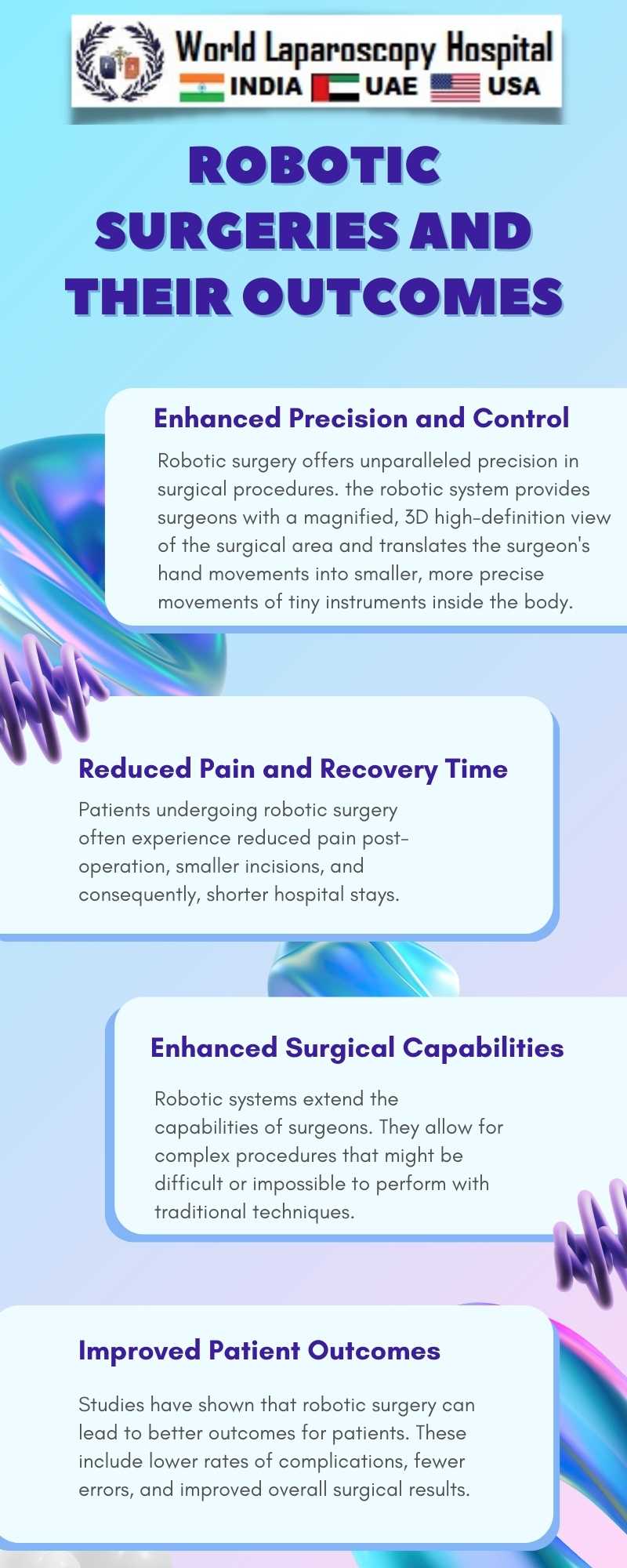Breakthrough Robotic Surgeries and Their Outcomes
Introduction
The integration of robotics into surgical procedures has revolutionized the medical field, offering unprecedented precision, reduced invasiveness, and improved patient outcomes. This essay examines various case studies to highlight the breakthroughs in robotic surgeries and their outcomes, focusing on diverse surgical fields including general surgery, urology, gynecology, and cardiothoracic surgery.

1. General Surgery: Robotic-Assisted Laparoscopic Surgery
A landmark case in general surgery involved a robotic-assisted laparoscopic cholecystectomy. The patient, suffering from gallstones, underwent this minimally invasive procedure. The robot's articulated instruments allowed for precise removal of the gallbladder, with the patient experiencing reduced postoperative pain and a quick recovery. This case set a precedent for the use of robotic assistance in laparoscopic surgeries, demonstrating its efficacy in reducing surgical trauma and hospital stay duration.
2. Urology: Robot-Assisted Radical Prostatectomy
In urology, a notable case was a robot-assisted radical prostatectomy performed on a patient with localized prostate cancer. The surgeon utilized a robotic system to delicately remove the prostate gland while preserving surrounding nerves, which significantly reduced the risk of postoperative incontinence and erectile dysfunction. This case underscored the advantage of robotic surgery in performing complex dissections and suturing in confined spaces.
3. Gynecology: Robotic Hysterectomy
Gynecological surgery saw a breakthrough with a robotic hysterectomy performed on a patient with early-stage uterine cancer. The precision of the robotic arms facilitated the careful removal of the uterus and affected tissues while minimizing damage to adjacent organs. The patient benefitted from reduced blood loss, fewer complications, and a faster return to normal activities.
4. Cardiothoracic Surgery: Robot-Assisted Coronary Artery Bypass
In cardiothoracic surgery, a pioneering case involved a robot-assisted coronary artery bypass. This procedure was performed on a patient with coronary artery disease, where the surgeon used robotic assistance to graft a vein with greater precision and stability than traditional methods. The patient had a reduced risk of infection and a shorter recovery period, highlighting the potential of robotic assistance in complex cardiovascular surgeries.
Conclusion
These case studies demonstrate the transformative impact of robotic surgery across various medical specialties. Robotic surgeries offer enhanced precision, reduced invasiveness, and better patient outcomes. However, it's crucial to acknowledge the need for specialized training for surgeons and the high costs associated with robotic systems. As technology advances, robotic surgery is poised to become more accessible and widely used, continuing to improve surgical outcomes and patient care.
The integration of robotics into surgical procedures has revolutionized the medical field, offering unprecedented precision, reduced invasiveness, and improved patient outcomes. This essay examines various case studies to highlight the breakthroughs in robotic surgeries and their outcomes, focusing on diverse surgical fields including general surgery, urology, gynecology, and cardiothoracic surgery.

1. General Surgery: Robotic-Assisted Laparoscopic Surgery
A landmark case in general surgery involved a robotic-assisted laparoscopic cholecystectomy. The patient, suffering from gallstones, underwent this minimally invasive procedure. The robot's articulated instruments allowed for precise removal of the gallbladder, with the patient experiencing reduced postoperative pain and a quick recovery. This case set a precedent for the use of robotic assistance in laparoscopic surgeries, demonstrating its efficacy in reducing surgical trauma and hospital stay duration.
2. Urology: Robot-Assisted Radical Prostatectomy
In urology, a notable case was a robot-assisted radical prostatectomy performed on a patient with localized prostate cancer. The surgeon utilized a robotic system to delicately remove the prostate gland while preserving surrounding nerves, which significantly reduced the risk of postoperative incontinence and erectile dysfunction. This case underscored the advantage of robotic surgery in performing complex dissections and suturing in confined spaces.
3. Gynecology: Robotic Hysterectomy
Gynecological surgery saw a breakthrough with a robotic hysterectomy performed on a patient with early-stage uterine cancer. The precision of the robotic arms facilitated the careful removal of the uterus and affected tissues while minimizing damage to adjacent organs. The patient benefitted from reduced blood loss, fewer complications, and a faster return to normal activities.
4. Cardiothoracic Surgery: Robot-Assisted Coronary Artery Bypass
In cardiothoracic surgery, a pioneering case involved a robot-assisted coronary artery bypass. This procedure was performed on a patient with coronary artery disease, where the surgeon used robotic assistance to graft a vein with greater precision and stability than traditional methods. The patient had a reduced risk of infection and a shorter recovery period, highlighting the potential of robotic assistance in complex cardiovascular surgeries.
Conclusion
These case studies demonstrate the transformative impact of robotic surgery across various medical specialties. Robotic surgeries offer enhanced precision, reduced invasiveness, and better patient outcomes. However, it's crucial to acknowledge the need for specialized training for surgeons and the high costs associated with robotic systems. As technology advances, robotic surgery is poised to become more accessible and widely used, continuing to improve surgical outcomes and patient care.
3 COMMENTS
Dr. Balamurugan Selva
#1
Jan 15th, 2024 10:54 am
Case studies reveal the transformative impact of robotic surgery in diverse medical specialties, showcasing enhanced precision, reduced invasiveness, and improved patient outcomes. Acknowledging the need for specialized training and high costs, ongoing technological advancements promise increased accessibility and widespread adoption, further enhancing surgical outcomes and patient care.
Dr. Mukesh Chopra
#2
Jan 18th, 2024 9:12 am
These case studies highlight robotic surgery's transformative impact in diverse medical specialties, providing enhanced precision, reduced invasiveness, and improved patient outcomes. Acknowledging the need for specialized surgeon training and high costs is crucial. As technology advances, robotic surgery is poised to become more accessible, continuing to enhance surgical outcomes and patient care widely.
Dr. K K Dwivedi
#3
Jan 20th, 2024 10:54 am
These case studies showcase the transformative impact of robotic surgery across medical specialties. Enhanced precision, reduced invasiveness, and improved outcomes are evident. Acknowledging the need for specialized training and high costs, as technology advances, robotic surgery is set to become more accessible, further improving surgical outcomes and patient care.
| Older Post | Home | Newer Post |

